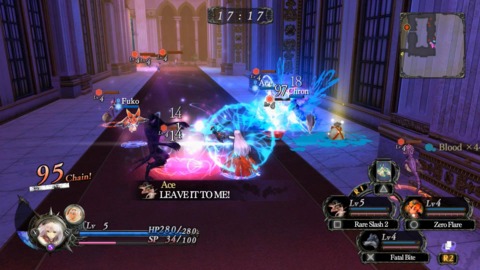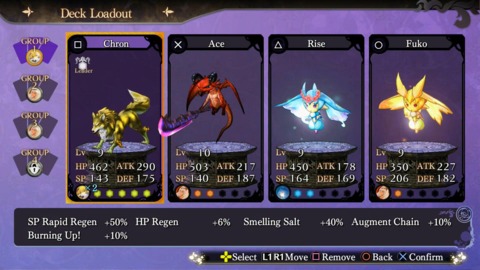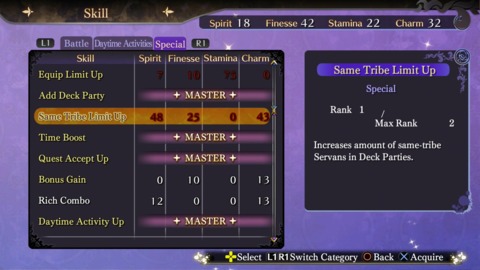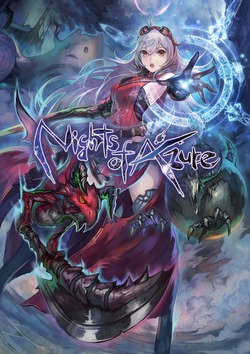Nights of Azure Review
Gust Co. Ltd, is a company best known for producing the Atelier franchise, a series of turn-based RPGs dating all the way back to the PlayStation. This style of game would become their go-to, as the Atelier series grew in popularity in Japan and reached a niche status in the West. It’s both odd and exciting to see Gust produce a game like Nights of Azure, which deviates quite a lot from their familiar formula. Drawing a lot of inspiration from their parent company’s Dynasty Warriors series, Gust’s Nights of Azure brings its own brand of hack ‘n’ slash gameplay to the table by mixing it with plenty of RPG elements.
Nights of Azure takes place in an alternate reality of Europe. A demon king attempted to invade the planet but was stopped by a warrior that sacrificed herself to seal the king away. The blood of the demon king turned those it spilled on into half-demons. Now, a saint must be sacrificed every so often to repress the Night, the gateway the demon king wishes to use to return to the world. Arnice, the game’s protagonist, is one of these half-demons, and her friend, Lilysse, is the next saint in line to attempt to seal way the night. While Lilysse willingly accepts her role as saint, Arnice actively tries to find another way to end the night, even if it means fighting the demon king alone.

Many RPGs suffer from pacing issues, be it through the main plot or ample side-material, but Nights of Azure does a good job of staying in a rhythm. The plot follows an episodic fashion as Arnice travels from location to location around Rusewall Island to uncover the mysteries of demonkind and the Curia, the organization that employs both her and Lilysse. Arnice’s character is thoroughly explored along the way. Her desires, faults, and relationships are all brought forward either through her interactions with people or dream world sequences where her half-demon conscious banters with manifestations of the demon king. Sadly, none of the supporting cast is laid out as well as Arnice. Many of them can be summed up with anime stereotypes such as “ditzy girl” or “ladies’ man,” titles they retain for the majority of Nights of Azure’s story.
A game is a sum of its parts though, and where Nights of Azure falls short in characterization, it attempts to make up for with gameplay. Nights of Azure follows a formula reminiscent of Dynasty Warriors. Arnice has three types of attack: light, heavy, and special. Light attacks can chain into various heavy attacks based on what part of a combo she’s in. Arnice’s normals and special are dictated by the weapon she has equipped, and she can unlock new weapons by leveling up. It’s a slow process at first, but once Arnice has a few weapons and the ability to change them mid-combo the game starts feel a little more varied in its combat. Specials are done by using part of Arnice’s SP meter. They hit hard and typically make Arnice impervious to damage during the full animation of the attack. They’re a good way to deal with crowds or when being overwhelmed, as specials often knock enemies away from Arnice when she completes one. SP isn’t just for special moves, as they are tied to Nights of Azure’s main gameplay gimmick, “servans.”

Servans are little familiars that act independently of Arnice, typically in full aggro, and engage anything that walks in combat. Despite this, certain servans can fill different purposes. In particular, the servan that provides auto-healing is invaluable as Arnice does not have access to consumable items that heal her. There’s also servans that can provide buffs and de-buffs as well as a few that make searching for rare items easier, which is a plus since many of the strongest servans are locked away behind items with normally low drop rates. The lackluster AI of the servans prevents them from feeling like something special, though. Servans take zero measures to dodge enemy attacks. Against bosses they will walk right into moves that can instantly kill them. The saving grace for the healing servan is that they constantly stay by Arnice’s side, so at least their ability to dodge is reliant on the player.
Arnice can have 4 decks of 4 servans each at any given time. Without investing points from leveling up and doing doing side-quests, she cannot have duplicates of the same servan across any of her decks (you can only have a healer in 1 deck unless you have a skill to allow you to run 2). Finding a good balance with servans is important though as they can also affect Arnice’s ability to transform. Arnice has multiple forms that she can unlock and use based on her servan loadout. Each of these forms turns her into an engine of destruction for a limited amount of time, where she becomes impervious to damage as well as being able to make use of various other skills depending on what form she has access to.

There’s a lot of optional grind to Nights of Azure. Arnice can take on quests and odd jobs between story sections that give her blood (to spend as EXP to level up and on servans), gold, various points she can allot onto skills, and sometimes items and equipment. Quests fall into 1 of 3 catagories: slaying a certain of monster, reaching a specific point on the map, or collecting a certain item. Rewards from quests are typically bad, a lot of times they give gold or equipment (with most of the best equipment being found in the field rather than a shop), but it gives an excuse to grind for blood from fighting demons. Blood is invaluable since it acts as experience to level up Arnice, a resource to unlock servans, and as a currency at the few shops that sell the best items.
Nights of Azure’s visuals are pretty good considering it was originally a Vita title. The pastel colors of the characters and demons looks rather nice. It all works together in a style reminiscent of cel-shading. While the visuals are nice though, some of models leave a bit to be desired. Arnice’s hair and coattails fly about in a physics all their own, continually clipping into each other, other parts of Arnice, and even the ground. Arnice and Lilysse are both well-endowed characters and the game makes sure you know with jiggle phsyics that could put Dead or Alive to shame at times. Other than these two gripes, there’s not anything out of place. The framerate stays consistent, an issue the original Vita version had, and rarely dips, if ever.
Where Nights of Azure really shines is its soundtrack. It’s an interesting mix of bombastic orchestral-rock and calming jazz. It’s not really a fusion one would expect. When combined with the visuals, it gives the game a similar gothic feel to older Metroidvania titles, just replace the platforming and exploration with hack ’n’ slash.
Nights of Azure is alright for an action RPG. It probably won’t be making any top games lists, but it certainly feels satisfying for its $40 price tag. If its combat were a little more refined, it could have potentially stood with other major action titles like Bayonetta or Devil May Cry. The game certainly introduces a lot of interesting gameplay concepts, but none of them particularly stand out as being fully realized.
